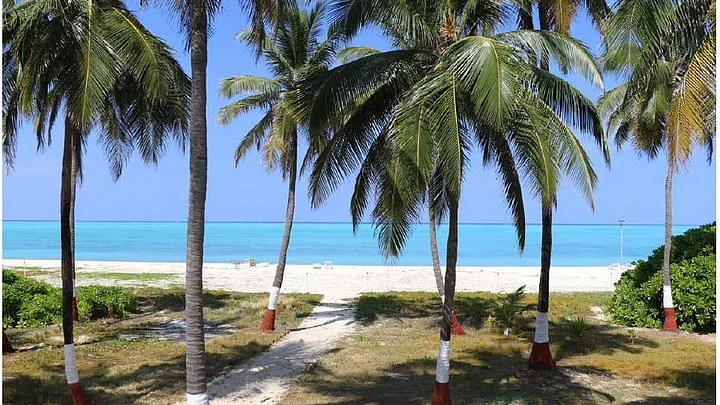Two beaches in Lakshadweep have been awarded the ‘Blue Flag’ tag, putting them on the list of the world’s cleanest and most eco-friendly “beaches, marinas, and sustainable boating tourism operators." With this, India now has a total of 12 Blue Flag beaches.
The beaches that were awarded the tag are Minicoy Thundi beach and Kadmat beach. Union Environment Minister Bhupender Yadav took to microblogging site Twitter to share the news.
What criteria does a beach need to meet to get the 'Blue Flag' classification? And which other beaches in India have been awarded this tag. Find out more below.
What is the 'Blue Flag' certification?
The ‘Blue Flag’ award is an eco-label awarded by Denmark-based non-profit Foundation for Environmental Education (FEE) to beaches, tourism boats, and marinas. A marina is a small harbour where mainly pleasure boats and yachts dock.
The FEE website says that in order to qualify for the Blue Flag, "a series of stringent environmental, educational, safety, and accessibility criteria must be met and maintained."
The programme was started in 1987, in Europe. A total of 5,042 beaches, marinas, and tourism boats in 48 countries have been awarded the label so far. It promotes sustianable development in freshwater and marine areas.
The certification is given by an international jury comprising members of the United Nations Environment Programme (UNEP), United Nations World Tourism Organisation (UNWTO), and International Union for the Conservation of Nature (IUCN), besides FEE, according to The Indian Express.
Which other Indian beaches have been awarded the 'Blue Flag' tag?
The two new beaches to have been awarded the tag are Minicoy Thundi beach and Kadmat beach. The 10 other Indian beaches that have been awarded the label, according to the FEE site, are Shivrajpur in Gujarat’s Devbhumi Dwarka district, Ghogla beach in Diu, Kasarkod (Uttara Kannada) and Padubidri (Udupi) in Karnataka, Kappad (Kozhikode) in Kerala, Eden beach in Puducherry, Kovalam in Tamil Nadu, Rushikonda in Andhra Pradesh, Golden beach in Puri, Odisha, and Radhanagar Swarajdeep in Andaman and Nicobar.
Kovalam and Eden got the Blue Flag last year. The other eight beaches received the certification in 2020, and were re-certified last year.
What are the criteria to get the award?
There are 33 criteria to be granted the eco-label. Below are some of the requirements. They can be further broken down into three perspectives —educational, environmental, and accessibility.
Information about the programme has to be showcased on the Blue Flag information board. If the Blue Flag is temporarily withdrawn, the beach operators are required to inform the public as to the reasons why the award was taken back.
Environmental education activities which promote the aims of the programme must be shared with beachgoers.
Bathing water quality information is also to be mentioned on the Blue Flag information board. Information on local eco-systems, environmental elements and cultural sites should also be displayed.
The public should be made aware of the code of conduct that reflects ‘appropriate laws and/or regulations governing the use of the beach and surrounding areas’.
The environment management criteria include keeping the beach and surrounding areas, such as paths, parking areas, and access paths to the beach always clean and maintained.
Among the accessibility criteria, there must be an adequate number of toilet or restroom facilities. Moreover, the toilet or restroom facilities are required to have controlled sewage disposal.
Drinking water as well as first aid equipment must be available at the beach. Unauthorised camping, driving and dumping must be prohibited on the beach.
All buildings and beach equipment have to be maintained. “Consideration must be given to the appearance of buildings and structures at the beach. They should be well integrated within the natural and built environment, should adhere to construction standards and meet environmental and aesthetic requirements,” says the Blue Flag beach criteria.
Dogs or pets, other than assistance dogs are banned on a Blue Flag beach. Animals are only permitted in the parking areas, walkways, and promenades in the inland beach area.
The public must have access to Blue Flag beaches preferably without paying any cost. However, at some beaches like private ones where a fee is required, the charge must be reasonable.
At least one Blue Flag beach in each municipality must be accessible to the physically disabled. “It is strongly recommended that all Blue Flag beaches have facilities that allow access by the physically disabled, granting them access to the beach, surrounding buildings, and the restroom facilities,” the Blue Flag beach criteria added.
There must also be one water sampling point, which must be located where the concentration of bathers is highest, according to the criteria.
Which country has the highest number of Blue Flag beaches?
Spain has the highest number of Blue Flag beaches with 614 as of 2021, followed by Greece with 545 and Turkey with 519, according to the FEE website.
